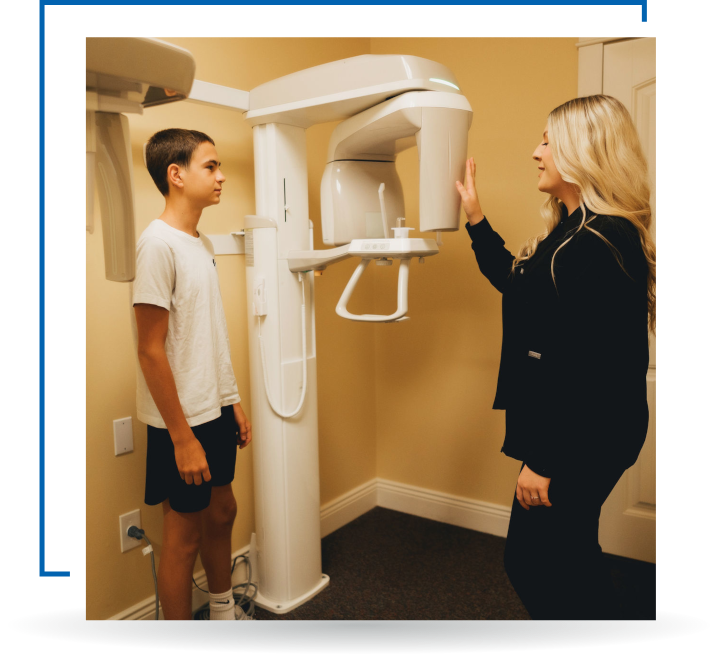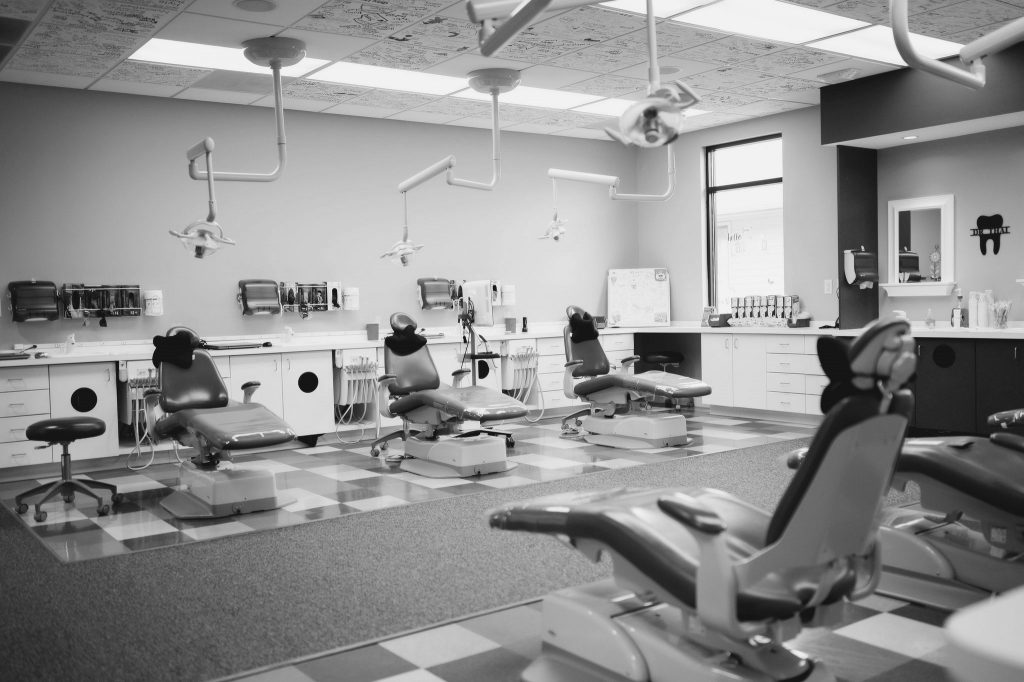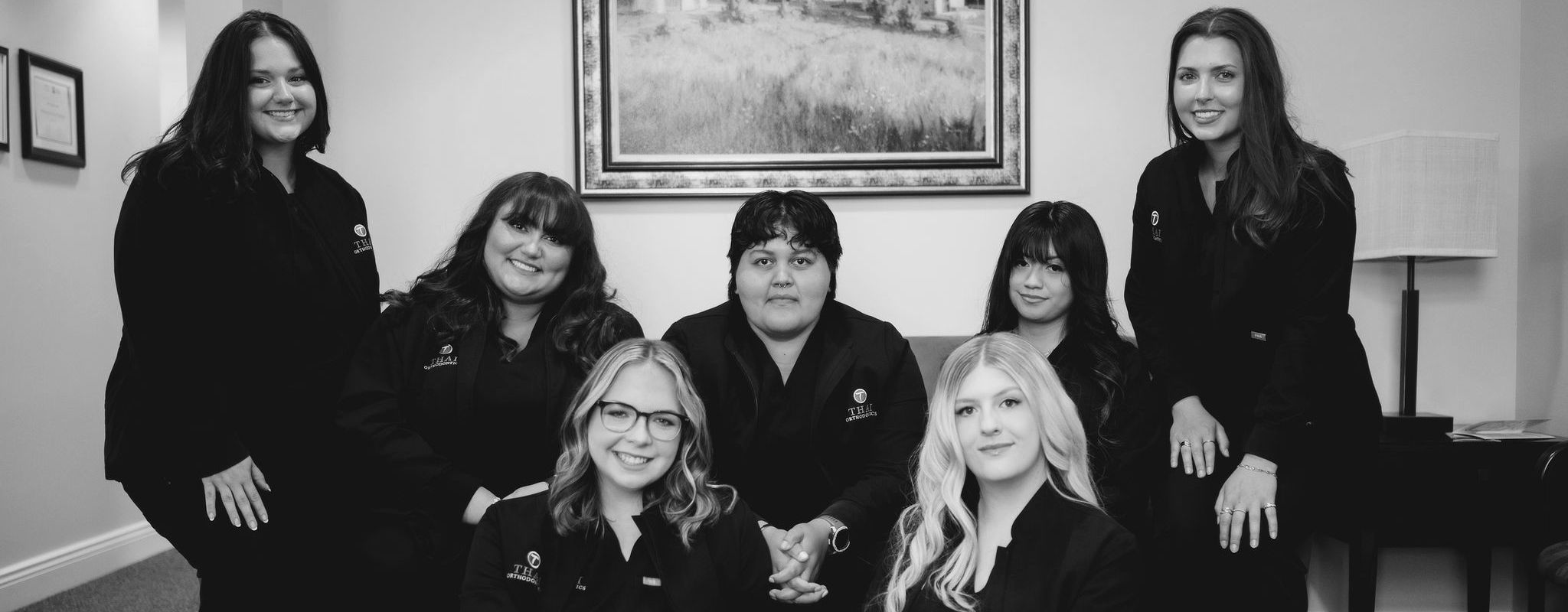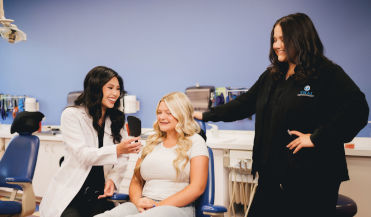Early Orthodontic Treatment in Grove City & Hilliard OH
We are especially attentive
to everyone’s individual needs.
Early Treatment
We are especially attentive
to everyone’s individual needs.
Early orthodontic treatment, ideally by age 7, will address potential dental issues. Early diagnosis improves treatment outcomes.
At Thai Orthodontics, Dr. Lauren Thai and her team are dedicated to helping every child achieve a healthy, confident, and beautiful smile. While orthodontic care can benefit patients of any age, the ideal time for a first orthodontic evaluation is around age 7. By this age, children typically have a mix of baby and permanent teeth, making it easier for an orthodontist to spot developing issues with tooth alignment or jaw growth.
The American Association of Orthodontists recommends that every child have an orthodontic screening by age 7, even if there are no visible signs of dental problems. Early evaluation allows Dr. Thai to detect potential growth and bite issues before they become more serious. When orthodontic treatment begins at the right time, it can make a significant difference in the outcome, often resulting in shorter, less complicated treatment and a healthier long-term smile.

Why Early Orthodontic Evaluations Are Important
Early orthodontic evaluations are not just about finding problems. They are about understanding how a child’s mouth is growing and ensuring that teeth and jaws develop in harmony. Dr. Thai uses advanced diagnostic tools to evaluate the relationship between a child’s teeth, jaws, and facial structure. She looks for signs of crowding, spacing, bite imbalances, and jaw alignment issues.
During this evaluation, Dr. Thai may recommend observation visits, where your child’s growth is monitored over time. This approach allows her to begin treatment at the most beneficial stage of development. If early (Phase One) orthodontic treatment is recommended, the goal is to create the ideal foundation for permanent teeth to come in properly and to help the jaws grow into the correct alignment.
Phase One treatment focuses on addressing skeletal and dental imbalances while a child’s bones are still developing. Treating certain issues early can prevent the need for more extensive procedures later in life, such as extractions or jaw surgery. For example, if the upper jaw is too narrow, early treatment can gently widen it, making room for permanent teeth and improving the bite before the jawbone fully hardens.


T
Teamwork
& Tradition
H
Health
& Humanity
A
Accountability
& Authenticity
I
Innovation
& Integrity

Common Signs Your Child May Need Early Orthodontic Treatment
Every child’s smile develops differently, but certain signs can indicate that an early orthodontic evaluation is necessary. Parents should be on the lookout for the following conditions:
- Early or late loss of baby teeth (most children begin losing teeth around age 5 and have all permanent teeth by age 13)
- Difficulty biting, chewing, or swallowing
- Persistent thumb-sucking or pacifier use after age 5
- Speech difficulties related to the position of the teeth
- Protruding front teeth or teeth that do not touch when biting
- Crossbites, underbites, or overbites that affect how the upper and lower teeth fit together
- Crowded, crooked, or overlapping teeth that are visible or detected on X-rays
- Mouth breathing, which may indicate jaw or airway development concerns
If you notice any of these warning signs, it is wise to schedule a consultation with Dr. Thai. Even if your child does not need treatment immediately, having an orthodontist monitor their growth ensures that any developing problems can be addressed at the best possible time.

Super fun atmosphere and great staff!
– Stephen
What Happens During an Early Orthodontic Evaluation
When you bring your child to Thai Orthodontics for an early orthodontic evaluation, the process is simple, gentle, and informative. Dr. Thai will start with a thorough visual examination and may take digital X-rays, photographs, or 3D scans of the teeth and jaws. These images help identify any underlying issues that may not be visible to the eye.
Dr. Thai will explain her findings in detail, answering any questions you may have about your child’s dental development. She will discuss whether early treatment is necessary or if observation is the best approach for now. In many cases, children are simply placed on a growth and development monitoring schedule, which allows Dr. Thai to track their progress and recommend treatment only when it is truly needed.
Parents often appreciate the peace of mind that comes from knowing their child’s dental health is being professionally monitored during critical growth years. Early detection allows for conservative, effective treatment that minimizes the risk of future complications.
Benefits of Early Orthodontic Treatment
Early orthodontic treatment, also known as interceptive treatment, can offer numerous benefits for growing children. By addressing developing dental and skeletal issues early, Dr. Thai can guide proper jaw growth and create the right amount of space for permanent teeth. Some of the key benefits include:
- Creating room for crowded or erupting teeth: Ensuring that permanent teeth have enough space to come in correctly reduces the need for tooth extractions later.
- Improving facial symmetry: Properly guided jaw growth supports balanced facial development and a harmonious smile.
- Reducing the risk of dental trauma: Children with protruding front teeth are more likely to experience accidental injury. Early correction lowers this risk.
- Preserving space for unerupted teeth: Early intervention can prevent teeth from becoming impacted or misaligned.
- Avoiding the need for permanent tooth removal: Addressing spacing and jaw growth problems early reduces the likelihood of removing permanent teeth in the future.
- Shortening treatment time with braces: Early correction often simplifies future treatment, leading to faster and more efficient results during Phase Two orthodontics.
Beyond the physical benefits, early orthodontic care can also boost a child’s confidence and comfort. Correcting bite or spacing issues can improve speech, make eating easier, and create a smile a child feels proud to show.
When Early Treatment Is Not Necessary
Not every child who is evaluated at age 7 will need early treatment. In many cases, Dr. Thai will simply recommend periodic observation. This approach allows her to monitor how the teeth and jaws are developing and begin treatment only when it will be most effective. The timing of orthodontic care is crucial, and starting too early or too late can affect results.
At Thai Orthodontics, parents can trust that Dr. Thai will recommend treatment only when it will truly benefit the patient. Her conservative and patient-centered approach ensures that each child receives the right care at the right time.
A Child-Friendly Approach to Orthodontic Care
Thai Orthodontics is known for its welcoming and supportive environment that helps children feel comfortable and confident. Dr. Thai and her staff take the time to explain each step of the process, helping young patients understand what to expect and reducing any anxiety they might feel.
The offices in both Grove City and Hilliard are designed with families in mind, offering a friendly and positive atmosphere. Parents appreciate the open communication, personalized treatment plans, and focus on long-term dental health.
Schedule an Early Orthodontic Evaluation in Grove City or Hilliard, OH
If your child is around age 7 or 8 and you have concerns about their dental development, schedule an evaluation with Dr. Thai. Whether your family dentist has recommended it or you simply want to ensure your child’s smile is developing properly, Thai Orthodontics can help.
During your visit, Dr. Thai will perform a comprehensive examination, discuss treatment options, and provide guidance tailored to your child’s unique needs. Early orthodontic care can make a lasting difference in your child’s oral health, comfort, and confidence.
Visit Thai Orthodontics in Grove City or Hilliard, Ohio, to learn more about early orthodontic treatment and schedule your child’s first orthodontic evaluation. Your child’s best smile begins with expert care and a caring approach from Dr. Thai and her experienced team.

YOUR BEAUTIFUL SMILE
starts here!
We look forward to working with you, and to being a part of this wonderful, life-changing experience.












